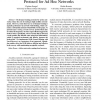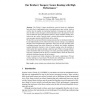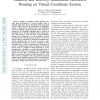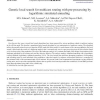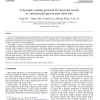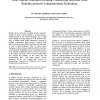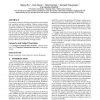ADHOC
2006
13 years 11 months ago
2006
Routing in ad-hoc networks is a complicated task because of many reasons. The nodes are low-memory, lowpowered, and they cannot maintain routing tables large enough for well-known ...
ADHOC
2006
13 years 11 months ago
2006
Abstract--On-demand routing protocols for ad hoc networks reduce the cost of routing in high mobility environments. However, route discovery in on-demand routing is typically perfo...
CORR
2008
Springer
13 years 11 months ago
2008
Springer
The Trinity [1] spam classification system is based on a distributed hash table that is implemented using a structured peer-to-peer overlay. Such an overlay must be capable of proc...
CORR
2008
Springer
13 years 11 months ago
2008
Springer
Abstract-- Stateless geographic routing provides relatively good performance at a fixed overhead, which is typically much lower than conventional routing protocols such as AODV. Ho...
CORR
2008
Springer
13 years 11 months ago
2008
Springer
Abstract. We propose a dynamic process for network evolution, aiming at explaining the emergence of the small world phenomenon, i.e., the statistical observation that any pair of i...
COR
2008
13 years 11 months ago
2008
Over the past few years, several local search algorithms have been proposed for various problems related to multicast routing in the off-line mode. We describe a population-based ...
CORR
2010
Springer
13 years 11 months ago
2010
Springer
Reactive routing protocols like Ad-hoc On-Demand Distance Vector Routing (AODV) and Dynamic Source Routing in Ad-Hoc Wireless Networks (DSR) which are used in Mobile and Ad-hoc Ne...
COMCOM
2008
13 years 11 months ago
2008
The idea of building query-oriented routing indices has changed the way of improving keyword search efficiency from the basis as it can learn the content distribution from the que...
CORR
2010
Springer
13 years 11 months ago
2010
Springer
Mobile Ad hoc Networks are highly dynamic networks. Quality of Service (QoS) routing in such networks is usually limited by the network breakage due to either node mobility or ene...
CCR
2008
13 years 11 months ago
2008
Conventional wisdom has held that routing protocols cannot achieve both scalability and high availability. Despite scaling relatively well, today's Internet routing system do...

